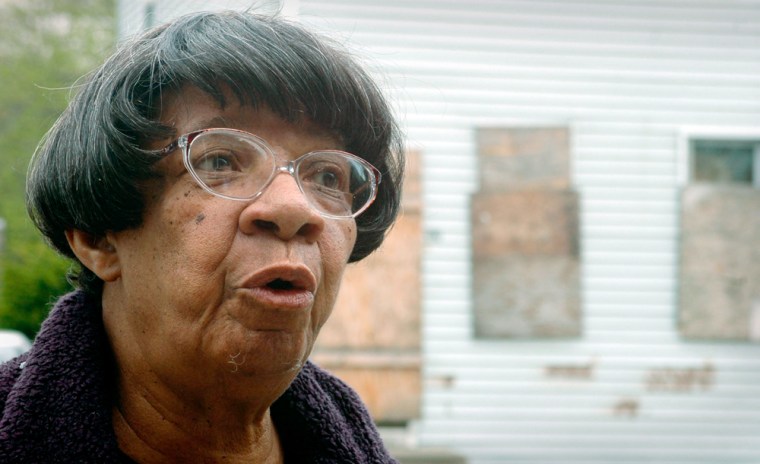Lula Williams doesn’t take a whiff of fresh air for granted. Not after living for nearly a quarter-century in front of a sewage treatment plant, around the corner from a factory and down the street from three scrap metal recyclers.
And that doesn’t include the trash incinerator, the power plant and the cement-grinding factory that have moved into her neighborhood since the early 1990s.
Living in one of America’s most factory-polluted areas has turned the 74-year-old woman and her neighbors into activists. But after five years of community protests and citizen lawsuits, the biggest improvement Williams can claim is a few millions dollars in equipment to lessen the stench from the sewage plant.
There are still many days when she opens the front door of her row house in Camden’s Waterfront South neighborhood and proclaims, “Lord have mercy, you just can’t breathe.”
Williams’ plight, like that of many trapped in dirty factory air, illustrates how difficult it is to free neighborhoods from the legacy of industrial pollution, an Associated Press review found.
“This is a poor, black neighborhood, Hispanic and white,” Williams said. “No other city or state that you go to would you find all this in it where residents live.”
Williams is now president of South Camden Citizens in Action, a group that has waged a five-year legal battle against the New Jersey Department of Environmental Protection for allowing the giant cement-grinding plant into their neighborhood.
Battles nationwide
The uphill battle mirrors others in the country, among them:
- In Ponca City, Okla., the Ponca Indian Tribe earlier this year sued Continental Carbon Co., alleging that air pollution from its plant is endangering children and the elderly. The company denies the allegations. The city also has sued Continental, contending that emissions have left the town covered with black soot.
- In suburban Detroit, the cities of Ecorse and River Rouge have filed lawsuits against U.S. Steel Corp., alleging pollution from the company’s plants is harming the health of residents and eroding real estate values. A U.S. Steel spokesman says the company has spent millions to correct environmental problems it inherited when it took over the bankrupt plant in 2003.
- In Madison, Wis., an environmental group has been fighting for more than a year to overturn a state decision permitting a foundry to increase by fivefold the particle emissions from its metal fabricating processes. An administrative law judge ruled this fall the increase didn’t violate state air quality standards, but ordered additional monitoring.
Waterfront South is the most polluted neighborhood in Camden, a former industrial center that’s home to more than 100 contaminated sites. Abandoned and operating smokestacks dot the city’s landscape, spewing out pollutants that force residents to breathe some of the unhealthiest air in the country.
AP’s analysis of government data found that seven Camden neighborhoods rank among the top 1 percent in the nation in the long-term health risk posed by industrial air pollution. All seven are majority black and Hispanic.
Windows closed
Melvin R. “Randy” Primas, a former mayor who is now the city’s chief operating officer, says Camden residents can’t open their windows in the summer because of the odors. “That is why we offered free indoor air filters to all the residents,” he said.
Primas, who was mayor when the county’s trash-to-steam generator was built in Waterfront South, said local officials are doing all they can to protect residents’ health and to revitalize the area without bringing in new pollution.
But he said that Waterfront South residents must understand that “the neighborhood that they are living in is the industrial corridor for Camden. If you look at what has been there for 100 years, it’s major industry.”
In the past five years, the state Department of Environmental Protection has issued more than 700 permits for air emissions in the city of Camden, ranging from school boilers to a metal alloy manufacturer that annually emits hundreds of pounds of chromium, a cancer-causing metal.
“The DEP has had no qualms about continuing to issue air permits for every facility in Waterfront South, without ever considering whether there is already such a high concentration of industry that it’s not safe to put more in,” said Olga Pomar, the legal services attorney who filed the lawsuit over the cement plant.
No new permits since 2002
DEP Commissioner Bradley Campbell said his agency hasn’t issued any emission permits for major new facilities in Waterfront South since 2002. “We’ve recognized the long-standing environmental neglect of Camden, particularly the Waterfront South area,” he said.
Campbell said the agency also has stepped up environmental enforcement and is developing a plan to mitigate the impact of pollution.
In the legal battle over the cement plant, residents won a victory in 2001 when a federal judge ruled they had been victims of racial discrimination. But legal setbacks followed and they now must prove— if the case goes to trial — that the state intentionally discriminated against them. “It’s a very hard standard,” Pomar said.
Still, their lawsuit over the sewage treatment plant produced a settlement in 1998 and $5 million in odor controls. And their protests helped persuade the city to reroute many diesel trucks that once clogged their neighborhood.
“You’re fighting along, you never stop, but you don’t see a huge blinding light at the end of your tunnel,” said the Rev. Michael Doyle, a priest for the past 30 years at Sacred Heart Catholic Church in Waterfront South. “You see little candles.”
Part I: Minorities suffer most from factory pollution
Part II: Weighing the risk to children
